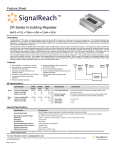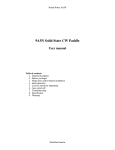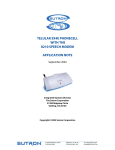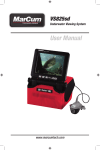Download Top Signal TS111651 TS111652 Manual
Transcript
Top Signal In-Building Repeaters Model: TS111651 800MHz Single Band Model: TS111652 1900 MHz Single Band Installation and Operations Manual For both TS111651 & TS111652 www.TopSignalProducts.com Page 1 Top Signal Table of Contents 1. General Information 1.1 Introduction 1.2 Specifications 1.3 Description 2 Installation 2.1 Introduction 2.2 Unpacking and Inspection 2.3 Preparation for Use 2.4 Before Installation 2.5 Antenna Installation 2.6 Bi-directional amplifier Installation 2.7 Connectors 2.8 Installation Example 3 Operation 3.1 Introduction 3.2 Operating Instructions 4 Trouble Shooting 5 Drawings Page 2 Top Signal General Information 1.1 Introduction This manual provides information pertaining to the installation and operation of Top Signals’ TS111651 800MHz and TS11652 1900MHz “Ultra Slim Home Repeater” Bi-Directional Amplifiers. These units are for CDMA, GSM, and TDMA modulations in the Cellular and PCS frequencies as shown in Table 1-1. <Table 1-1: TS111651 / TS111652 Bi-Directional Amplifier > Model Number Down Link* Frequencies Up Link** Frequencies TS111651 869 ~ 894 MHz 824 ~ 849 MHz TS111652 1930 ~ 1990 MHz 1850 ~ 1910 MHz Modulation CDMA,GSM ,TDMA CDMA,GSM , TDMA *: Down Link is from base station to mobile **: Up Link is from mobile to base station Please Note: Both the TS111651 single-band 800MHz and the TS111662 single-band 1900MHz amplifiers are setup and operated in the same manner. Going forward, this manual will refer to these amplifiers as “Top Signal 65”. Page 3 Top Signal 1.2 Specifications TS111651 Specifications – 800MHz Single Band ITEM Frequency Input Power Linear Gain (Center Freq.) Output Power (Center Freq.) Down Link Up Link Down Link Up Link Down Link Up Link Down Link Up Link SPECIFICATION 869 ~ 894 MHz 824 ~ 849 MHz - 28 dBm max/Total - 28 dBm max/Total 65 dB ( ±1 dB ) 65 dB ( ±1 dB ) + 12 dBm/CDMA1FA Up / Down link ALC Range > 25 dB Gain Flatness < 5 dB max (p – p) Fc ± 750 KHz -45 dBc ( RBW =30 KHz ) Spurious Fc ± 1.98 MHz -50 dBc ( RBW =30 KHz ) 1 dB Compression + 22 dBm rd 3 Order Intercept + 31 dBm Down / Up Shutdown Level +14 dBm ( ±1 dB) Noise Figure, Typical < 5 dB Propagation Delay < 1 µs max VSWR, Typical < 1.6 : 1 GREEN ON : Power Normal Alarm & Status RED 1 ON : Down link Fail RED 2 ON : Up link Fail Power Consumption 5.3 V / 750 mA Input Voltage (Adapter) RF Connectors Operating Temperature Storage Dimensions( W x H x D , inch) Weight FCC Type Acceptance DC 5.3 V / 1.8 A N-Type Connector -10 °C to 40 °C -30 °C to 80 °C 5.8” x 4.6” x 1.9” 1.4 Kg ( 3.1 lb ) Q4EUHSR-800H Page 4 Top Signal TS111652 Specifications – 1900MHz Single Band ITEM Frequency Input Power Linear Gain (Center Freq.) Output Power (Center Freq.) Down Link Up Link Down Link Up Link Down Link Up Link Down Link Up Link SPECIFICATION 1930 ~ 1990 MHz 1850 ~ 1910 MHz - 28 dBm max/Total - 28 dBm max/Total 65 dB ( ±1 dB ) 65 dB ( ±1 dB ) + 12 dBm/CDMA1FA Up / Down link ALC Range > 25 dB Gain Flatness < 5 dB max (p – p) Fc ± 885 KHz -45 dBc Spurious Fc ± 1.98 MHz -50 dBc 1 dB Compression + 22 dBm rd 3 Order Intercept + 31 dBm Down / Up Shutdown Level +14 dBm ( ±1 dB) Noise Figure, Typical < 5 dB Propagation Delay < 1 µs max VSWR, Typical < 1.6 : 1 GREEN ON : Power Normal Alarm & Status RED 1 ON : Down link Fail RED 2 ON : Up link Fail Power Consumption 5.3 V / 900 mA Input Voltage (Adapter) RF Connectors Operating Temperature Storage Dimensions( W x H x D , inch) Weight CE Mark DC 5.3 V / 1.8 A N-Type Connector -10 °C to 40 °C -30 °C to 80 °C 5.8” x 4.6” x 1.9” 1.4 Kg ( 3.1 lb ) Page 5 Top Signal 1.3 Description This product is designed for small offices, home offices, garages and parking lots, helping to improve signal strength and wireless network coverage inside. Outdoor antenna receives signal from base stations, then the TOP SIGNAL 65 Bi-Directional Amplifier amplifies the signal. Boosted signal is passed through to the indoor antenna(s). Conversely, signals from handsets are amplified, and then transmitted to the base stations. Installation 2.1 Introduction This section provides information for the installation and setup of the TOP SIGNAL 65 Bi-Directional Amplifier. The information consists of procedures for unpacking, inspection and preparation for the installation, as well as the actual installation and the setup. 2.2 Unpacking and Inspection Examine the shipping carton for damage before unpacking the unit. If the shipping carton is damaged, try to have the carrier’s agent present when the equipment is unpacked. If visual inspection reveals physical damage(s) to the equipment, you should send it back for replacement. Verify that the equipment is complete, as listed on the packing slip. Contact the seller if any component is missing. 2.3 Preparation for Use 2.3.1 Power Requirements The power supply of the TOP SIGNAL 65 accepts 5.4 VDC. Power consumption of the TOP SIGNAL 65 is approximately 4.0 Watts. 2.3.2 Operating Environment The TOP SIGNAL 65 is intended for indoor use only. Do not install it where it might be exposed to the outside elements as this could result in destruction of the unit and other hazards. For normal operations, the environmental conditions should be as follow: Temperature range: –10 °C to 40 °C Maximum Humidity: 95 % Page 6 Top Signal 2.4 Before Installation You will need to determine the following before beginning the TOP SIGNAL 65 installation: a. Location where the outdoor antenna is to be installed b. Location where the indoor antenna is to be installed c. Location where the TOP SIGNAL 65 is to be installed d. Length and type of coaxial cable needed to connect from the outdoor antenna to the bi-directional amplifier e. Length and type of coaxial cable needed to connect from the bi-directional amplifier unit to the indoor antenna 2.5 Antenna Installation 2.5.1 Outdoor Antenna Select a site for your outdoor antenna, making sure that you have enough signal strength at that location. Connect the antenna to the bi-directional amplifier using an RF coaxial cable. Please refer to the instructions provided by the manufacturer for antenna installation. If you are using a directional antenna such as a Yagi type, a Patch type, you may want to install the antenna temporarily first. You can come back and optimize once you have installed and powered up the bi-directional amplifier. 2.5.2 Indoor Antenna Install the indoor antenna at a convenient location. It should be free of metallic obstructions in order to have an effective coverage. Depending on the circumstance of the installation, either one or a combination of following antennas can be used: Ceiling mount antenna, Wall mount patch antenna omni-directional antenna and Corner reflector antenna. 2.6 Bi-directional amplifier Installation TOP SIGNAL 65 is an indoor bi-directional amplifier. Accordingly, the environment of the intended installation site needs to be considered. The bi-directional amplifier must be shielded from moisture, such as rain, and excessive temperatures. The operating temperatures should be between -10 °C and 40 °C. Page 7 Top Signal 2.6.1 Turn-On Procedure Caution! Please make sure all RF connectors are tightened and cables and antennas are connected. Powering up the unit with no antenna attached might cause irreparable damage to the amplifier. Once you verify that the antennas are attached correctly, Connect AC/DC Adaptor on the bi-directional amplifier’s DC IN connector. Then switch the ON / OFF switch to ON position. The Power indicator LED should be green. Verify that none of the “ALARM” LEDs is illuminated. If an ALARM LED is lit, consult the trouble shooting pages of this manual, or “2.6.2 Antenna Isolation and Alignment” section. 2.6.2 Antenna Isolation and Alignment Good isolation between the two antennas is critical for the operation of the repeater system. This is not an issue as long as the distance between the outside antennas and the inside antenna is at least 15 ft, there is a wall between them, and the outside antenna is not pointed toward the inside antenna. TOP SIGNAL 65 is equipped with an over drive protection circuit, which will also detect the isolation problem between the antennas. This alarm is indicated by a blinking “ALARM” LED. 2.6.2.1 Antenna Alignment If you are triggering the overdrive alarms at any point, try to increase the isolation between the antennas by relocating the indoor antenna. The indoor antenna should be placed physically as far away from the outdoor antenna as practical. If you are using directional antennas, try to find a location for the indoor antenna where it can cover the needed area and oriented back to back with respect to the outdoor antenna. <Optional> At this point, you may want to optimize the outdoor antenna. If the outdoor antenna can be turned in place, try turning it from one end to the other by one inch increment. At each point, observe the signal strength in indoor coverage area. When you find the best direction for the outdoor antenna, tie down everything and secure the antenna. Page 8 Top Signal 2.7 Connectors Figure 2-7 shows the connectors and Table 2-7 provides a description of each connector on the TOP SIGNAL 65 unit <Table 2-7: TOP SIGNAL 65 Connectors> Label Description Connect AC/DC Adaptor for supplying DC power to the unit DC IN TO BASE N-Type connector transmits signal to and from base stations. Connects to the outdoor antenna. TO MOBILE N-Type connector transmits signal to and from mobile phones. Connects to the indoor antenna. ON / OFF Power On / Off switch for the unit. <Figure 2-7:TOP SIGNAL 65 Connectors> ON OFF DC IN TO BASE TO MOBILE Page 9 Top Signal Installation Example TOP SIGNAL 65 can be installed with multiple indoor antennas as shown in Figure 2-8. 1. <Figure 2-8: TOP SIGNAL 65 Installation Example> Page 10 Top Signal Operation 3.1 Introduction This section provides information for operating the TOP SIGNAL 65 Bi-Directional Amplifier. 3.2 Operating Instruction 3.2.1 Power-up Connect the Bi-Directional Amplifier to AC/DC Adaptor. If no ALARM condition is present, only the “POWER” LED will remain lit. The Bi-Directional Amplifier is then operating properly. 3.2.2 Automatic Level Control TOP SIGNAL 65 is equipped with an Automatic Level Control (ALC) both on the up-link and down-link. ALC automatically adjusts the gain of the amplifier depending on the strength of the input signal. This feature, for example, helps prevent amplifier shut down when you are making a call near the service (indoor) antenna. 3.2.3 ALARM Status There are overdrive fail alarms on the unit, one for the up link, “Tx ALARM”, the other for down link “Rx ALARM”. Over driving occurs when the RF output power of the Bi-Directional Amplifier exceeds a prescribed limit. This means that the input RF power level is too high, or the Bi-Directional Amplifier is oscillating. The condition may be transient, caused by a passing emergency vehicle emitting a strong signal for example, or permanent, due to the proximity to a base station. It may also indicate low isolation between the antennas, (please refer to the section 2.6.2 of this manual for antenna alignment and isolation.) The overdrive fail on the TOP SIGNAL 65 Bi-Directional Amplifier is design to detect whether the over driving is transient or permanent. If the output power level of Up Link exceeds a prescribed limit, Up link is disconnected and the FAIL LED (RED) turns on. Bi-Directional Amplifier automatically checks output power level every 1 minute of a 5 minute cycle. During this cycle, if the output power returns to normal, the amplifier will revert to its normal operation mode. However, if the over-power condition persists after 5 minutes, the amplifier will shut it self down. 3.2.4 Corrective Actions In the event of a shut down, re-aligning or moving the indoor and/or outdoor antennas may solve the problem. To reset the amplifier, disconnect the power supply, wait for at least 20 seconds, and plug in the power supply back again. Page 11 Top Signal Troubleshooting If the bi-directional amplifier does not operate properly after installation, first check that the installation procedures as described in section 2 of this manual were followed correctly. Inspect each connection, both RF and AC, and connectors for a secure fit, checking to see if all the connections are made to the proper ports of the unit and the antennas. If the malfunction is due to an alarm condition, refer to the appropriate part of the section 3.2 of this manual. Corrective actions may be taken for the overdrive alarms. CAUTION! There are no user serviceable parts in Top Signal 65. DO NOT OPEN the unit. There is a danger of an electric shock. Opening the covers of the unit will void all warranties. Page 12 Top Signal Drawings 5.1 Front and Back views <Figure 55-1: TOP SIGNAL 65 Front and Back views> Front View POWER TX FAIL RX FAIL Page 13 Top Signal 5.2 Top and Bottom Views <Figure 5-2: TOP SIGNAL 65 Top and Bottom views> Top View ON OFF DC IN Bottom View TO BASE TO MOBILE Page 14 Top Signal 5.3 Side views <Figure 5-3: TOP SIGNAL 65 Side view> Page 15






















